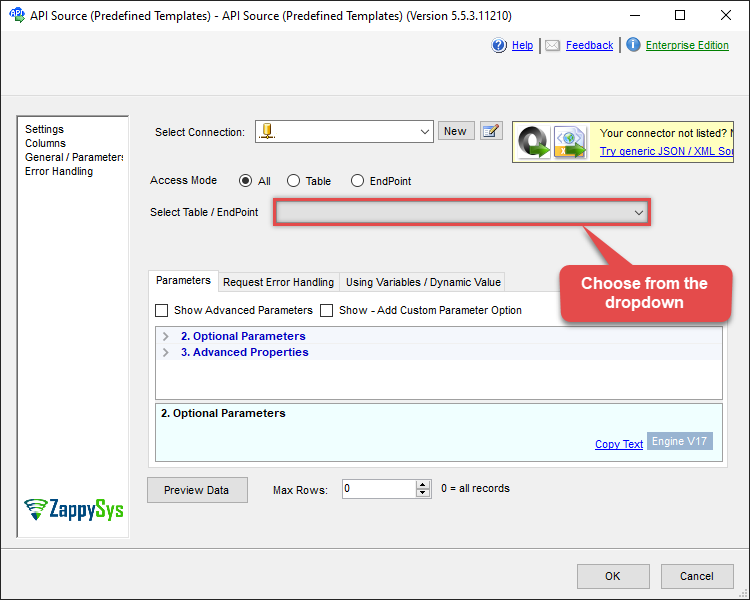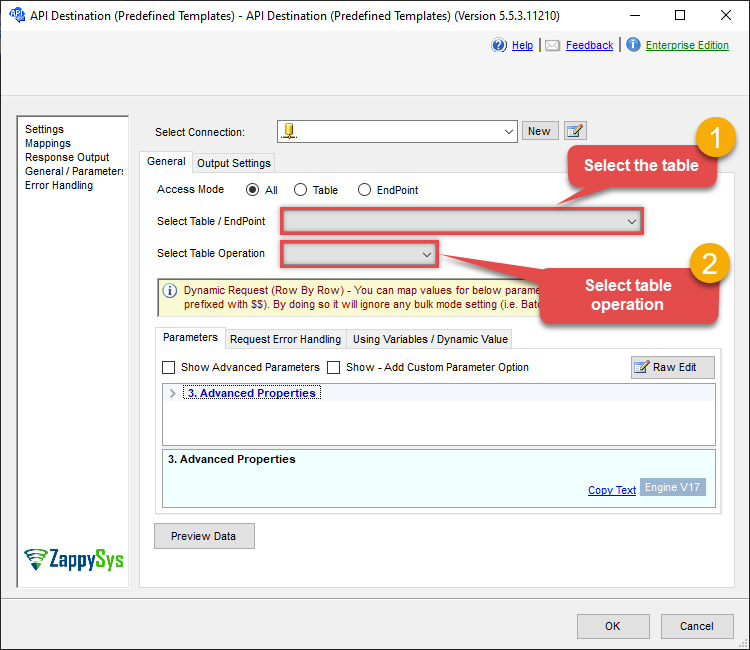Table __DynamicRequest__
Description
This is a generic table. Use this to support Bulk read / write. You can supply Dynamic URL
Supported Operations
Below section contains supported CRUD operations. Each operation is executed by some EndPoint behind the scene.| Method | Supported | Reference EndPoint |
|---|---|---|
| SELECT | generic_request | |
| INSERT | generic_request_bulk_write | |
| UPDATE | generic_request_bulk_write | |
| UPSERT | ||
| DELETE | ||
| LOOKUP |
Examples
SSIS
Use OData Connector in API Source component to read data or in API Destination component to read/write data:
Read from Generic Table (Bulk Read / Write) table using API Source

API Source - OData
OData Connector can be used to integrated any REST API which supports OData Standard. You can view tables, read data from tables using this connector. It also comes with some example OData Services to get started.
OData
Generic Table (Bulk Read / Write)
| Required Parameters | |
|---|---|
| HTTP - Url or File Path | Fill-in the parameter... |
| HTTP - Request Method | Fill-in the parameter... |
| Optional Parameters | |
| HTTP - Request Body | |
| HTTP - Is MultiPart Body (Pass File data/Mixed Key/value) | |
| HTTP - Request Format (Content-Type) | ApplicationJson |
| HTTP - Headers (e.g. hdr1:aaa || hdr2:bbb) | Accept: */* || Cache-Control: no-cache |
| Parser - Response Format (Default=Json) | Default |
| Parser - Filter (e.g. $.rows[*] ) | |
| Parser - Encoding | |
| Parser - CharacterSet | |
| Download - Enable reading binary data | False |
| Download - File overwrite mode | AlwaysOverwrite |
| Download - Save file path | |
| Download - Enable raw output mode as single row | False |
| Download - Raw output data RowTemplate | {Status:'Downloaded'} |
| Download - Request Timeout (Milliseconds) | |
| General - Enable Custom Search/Replace | |
| General - SearchFor (e.g. (\d)-(\d)--regex) | |
| General - ReplaceWith (e.g. $1-***) | |
| General - File Compression Type | |
| General - Date Format | |
| General - Enable Big Number Handling | False |
| General - Wait time (Ms) - Helps to slow down pagination (Use for throttling) | 0 |
| JSON/XML - ExcludedProperties (e.g. meta,info) | |
| JSON/XML - Flatten Small Array (Not preferred for more than 10 items) | |
| JSON/XML - Max Array Items To Flatten | 10 |
| JSON/XML - Array Transform Type | |
| JSON/XML - Array Transform Column Name Filter | |
| JSON/XML - Array Transform Row Value Filter | |
| JSON/XML - Array Transform Enable Custom Columns | |
| JSON/XML - Enable Pivot Transform | |
| JSON/XML - Array Transform Custom Columns | |
| JSON/XML - Pivot Path Replace With | |
| JSON/XML - Enable Pivot Path Search Replace | False |
| JSON/XML - Pivot Path Search For | |
| JSON/XML - Include Pivot Path | False |
| JSON/XML - Throw Error When No Match for Filter | False |
| JSON/XML - Parent Column Prefix | |
| JSON/XML - Include Parent When Child Null | False |
| Pagination - Mode | |
| Pagination - Attribute Name (e.g. page) | |
| Pagination - Increment By (e.g. 100) | 1 |
| Pagination - Expression for Next URL (e.g. $.nextUrl) | |
| Pagination - Wait time after each request (milliseconds) | 0 |
| Pagination - Max Rows Expr | |
| Pagination - Max Pages Expr | |
| Pagination - Max Rows DataPath Expr | |
| Pagination - Max Pages | 0 |
| Pagination - End Rules | |
| Pagination - Next URL Suffix | |
| Pagination - Next URL End Indicator | |
| Pagination - Stop Indicator Expr | |
| Pagination - Current Page | |
| Pagination - End Strategy Type | DetectBasedOnRecordCount |
| Pagination - Stop based on this Response StatusCode | |
| Pagination - When EndStrategy Condition Equals | True |
| Pagination - Max Response Bytes | 0 |
| Pagination - Min Response Bytes | 0 |
| Pagination - Error String Match | |
| Pagination - Enable Page Token in Body | False |
| Pagination - Placeholders (e.g. {page}) | |
| Pagination - Has Different NextPage Info | False |
| Pagination - First Page Body Part | |
| Pagination - Next Page Body Part | |
| Csv - Column Delimiter | , |
| Csv - Has Header Row | True |
| Csv - Throw error when column count mismatch | False |
| Csv - Throw error when no record found | False |
| Csv - Allow comments (i.e. line starts with # treat as comment and skip line) | False |
| Csv - Comment Character | # |
| Csv - Skip rows | 0 |
| Csv - Ignore Blank Lines | True |
| Csv - Skip Empty Records | False |
| Csv - Skip Header Comment Rows | 0 |
| Csv - Trim Headers | False |
| Csv - Trim Fields | False |
| Csv - Ignore Quotes | False |
| Csv - Treat Any Blank Value As Null | False |
| Xml - ElementsToTreatAsArray | |

Read/write to Generic Table (Bulk Read / Write) table using API Destination

API Destination - OData
OData Connector can be used to integrated any REST API which supports OData Standard. You can view tables, read data from tables using this connector. It also comes with some example OData Services to get started.
OData
Generic Table (Bulk Read / Write)
Select
| Required Parameters | |
|---|---|
| HTTP - Url or File Path | Fill-in the parameter... |
| HTTP - Request Method | Fill-in the parameter... |
| Optional Parameters | |
| HTTP - Request Body | |
| HTTP - Is MultiPart Body (Pass File data/Mixed Key/value) | |
| HTTP - Request Format (Content-Type) | ApplicationJson |
| HTTP - Headers (e.g. hdr1:aaa || hdr2:bbb) | Accept: */* || Cache-Control: no-cache |
| Parser - Response Format (Default=Json) | Default |
| Parser - Filter (e.g. $.rows[*] ) | |
| Parser - Encoding | |
| Parser - CharacterSet | |
| Download - Enable reading binary data | False |
| Download - File overwrite mode | AlwaysOverwrite |
| Download - Save file path | |
| Download - Enable raw output mode as single row | False |
| Download - Raw output data RowTemplate | {Status:'Downloaded'} |
| Download - Request Timeout (Milliseconds) | |
| General - Enable Custom Search/Replace | |
| General - SearchFor (e.g. (\d)-(\d)--regex) | |
| General - ReplaceWith (e.g. $1-***) | |
| General - File Compression Type | |
| General - Date Format | |
| General - Enable Big Number Handling | False |
| General - Wait time (Ms) - Helps to slow down pagination (Use for throttling) | 0 |
| JSON/XML - ExcludedProperties (e.g. meta,info) | |
| JSON/XML - Flatten Small Array (Not preferred for more than 10 items) | |
| JSON/XML - Max Array Items To Flatten | 10 |
| JSON/XML - Array Transform Type | |
| JSON/XML - Array Transform Column Name Filter | |
| JSON/XML - Array Transform Row Value Filter | |
| JSON/XML - Array Transform Enable Custom Columns | |
| JSON/XML - Enable Pivot Transform | |
| JSON/XML - Array Transform Custom Columns | |
| JSON/XML - Pivot Path Replace With | |
| JSON/XML - Enable Pivot Path Search Replace | False |
| JSON/XML - Pivot Path Search For | |
| JSON/XML - Include Pivot Path | False |
| JSON/XML - Throw Error When No Match for Filter | False |
| JSON/XML - Parent Column Prefix | |
| JSON/XML - Include Parent When Child Null | False |
| Pagination - Mode | |
| Pagination - Attribute Name (e.g. page) | |
| Pagination - Increment By (e.g. 100) | 1 |
| Pagination - Expression for Next URL (e.g. $.nextUrl) | |
| Pagination - Wait time after each request (milliseconds) | 0 |
| Pagination - Max Rows Expr | |
| Pagination - Max Pages Expr | |
| Pagination - Max Rows DataPath Expr | |
| Pagination - Max Pages | 0 |
| Pagination - End Rules | |
| Pagination - Next URL Suffix | |
| Pagination - Next URL End Indicator | |
| Pagination - Stop Indicator Expr | |
| Pagination - Current Page | |
| Pagination - End Strategy Type | DetectBasedOnRecordCount |
| Pagination - Stop based on this Response StatusCode | |
| Pagination - When EndStrategy Condition Equals | True |
| Pagination - Max Response Bytes | 0 |
| Pagination - Min Response Bytes | 0 |
| Pagination - Error String Match | |
| Pagination - Enable Page Token in Body | False |
| Pagination - Placeholders (e.g. {page}) | |
| Pagination - Has Different NextPage Info | False |
| Pagination - First Page Body Part | |
| Pagination - Next Page Body Part | |
| Csv - Column Delimiter | , |
| Csv - Has Header Row | True |
| Csv - Throw error when column count mismatch | False |
| Csv - Throw error when no record found | False |
| Csv - Allow comments (i.e. line starts with # treat as comment and skip line) | False |
| Csv - Comment Character | # |
| Csv - Skip rows | 0 |
| Csv - Ignore Blank Lines | True |
| Csv - Skip Empty Records | False |
| Csv - Skip Header Comment Rows | 0 |
| Csv - Trim Headers | False |
| Csv - Trim Fields | False |
| Csv - Ignore Quotes | False |
| Csv - Treat Any Blank Value As Null | False |
| Xml - ElementsToTreatAsArray | |

ODBC application
Use these SQL queries in your ODBC application data source:
Get __DynamicRequest__
SELECT * FROM __DynamicRequest__SQL Server
Use these SQL queries in SQL Server after you create a data source in Data Gateway:
Get __DynamicRequest__
DECLARE @MyQuery NVARCHAR(MAX) = 'SELECT * FROM __DynamicRequest__';
EXEC (@MyQuery) AT [LS_TO_ODATA_IN_GATEWAY];